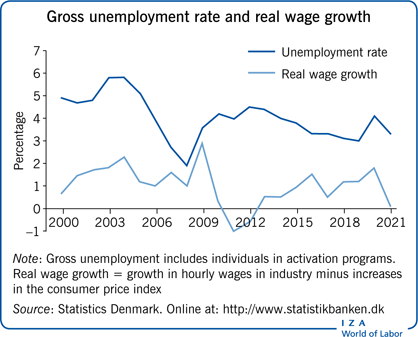Elevator pitch
Denmark is often highlighted as a “flexicurity” country with lax employment protection legislation, generous unemployment insurance, and active labor market policies. This model has coped with the Great Recession and the Covid-19 pandemic, avoiding large increases in long-term and structural unemployment. The recovery from Covid-19 alongside re-openings has been swift, so labor market effects were temporary. A string of recent reforms has boosted labor supply and employment; although fiscal sustainability is ensured, demographic changes challenge the labor market. Real wage growth has been positive and responded—with some lag—to unemployment.

Key findings
Pros
Employment rates are high, increasing in recent years due to cyclical factors and structural reforms.
High job turnover rates ensure most unemployment spells are short, preventing increases in unemployment raising structural unemployment.
Resilience to the Great Recession and the Covid-19 pandemic has avoided sharp increases in long-term and youth unemployment.
Wage adjustment has been flexible, preserving wage competitiveness.
There are few working poor.
Cons
A large share of youth enters the labor market with a low qualification level; this is especially challenging because there are few low-skilled jobs.
Average working hours are low.
Job turnover may be detrimental to human capital accumulation.
Wage inequality is widening moderately.
Demographic changes challenge the labor market.